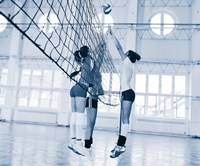
While the latter diagnosis seems to be announced with increasing frequency, the truth is that high ankle sprains account for fewer than 10% of all ankle sprains. And knowing the difference between these two injuries is critical to an athlete’s treatment and long-term recovery.
A Range of Sprains
“The diagnosis of high ankle sprain is overused and sometimes abused because it’s trendy and because of a lack of knowledge,” says orthopedic surgeon William C. McGarvey, MD, who is fellowship trained in foot and ankle injuries and affiliated with the Memorial Hermann | Rockets Sports Medicine Institute. “Oftentimes the diagnosis of high ankle sprain is applied to a severe ankle sprain.”
The ligament damage that occurs in both types of ankle sprains can range from a strain to a slight tear to a complete tear. What differentiates them is how the injury occurs and which ligaments are damaged. With the common sprain, the damaged ligament is on the outside of the ankle.
“This happens when an athlete lands on the foot and the ankle rolls outward and the foot faces inward,” says Dr. McGarvey, who is an associate professor at The University of Texas Medical School at Houston and director of its orthopedic surgery residency program. “It’s like you’re standing on the outside of your foot.”
In high ankle sprains, the damaged ligaments are above the ankle joint between the tibia (shinbone) and fibula (smaller calf bone on outside of leg). Dr. McGarvey says these sprains are caused by a high level of force and can sometimes be diagnosed by watching game film to see which way the ankle turned. Typically, a strong and sudden force strikes the outside of the leg causing it to turn outward at the ankle with an unnatural external rotation. As a result, the deltoid ligament on the inside of the ankle can tear.
High ankle sprains are most common in sports where the foot is planted and the body rolls away from the foot. “The body is not used to being in this position, or twisting in this way,” says Dr. McGarvey, who serves as assistant team physician for the Houston Rockets and team physician for the Katy High School football team.
Football probably accounts for the majority of high ankle sprains since lineman have little control over who falls on them. Soccer, basketball and volleyball contribute to the occurrence because of sudden cuts and pivots. In gymnastics, complex landings and dismounts are the causes.
Different Sprains, Different Treatments
Applying ice and rest are appropriate for both traditional and high ankle sprains, but that’s where the similarities end. According to Dr. McGarvey, trying to walk off a high ankle sprain can delay or permanently interfere with healing.
“The simple act of walking creates a separation of the tibia and fibula,” he explains. “Putting weight on the ankle re-creates the injury and can spread the bones further apart. That’s why it’s important to differentiate between the two types of sprains because the treatment for each is very different.”
Complete immobilization of the ankle, with a boot or cast, is required for high ankle sprains. The patient must use crutches to keep weight off the injured leg. This treatment can last up to six weeks.
Depending on the severity of ligament damage and how much separation exists between the tibia and fibula, surgery may be required. This could delay an athlete from returning to play for up to six months.
Dr. McGarvey says high ankle sprains, if treated properly, do not generally reoccur nor do they cause long-term problems. To help prevent ankle injuries of any type, he strongly suggests athletes work on ankle strengthening and balance training, even if this requires hiring a trainer or physical therapist.
Contact Us
For more information on the Rockets Sports Medicine Institute orthopedic doctors or surgeons, treatment for injuries, scheduling Human Performance services, or getting more information about physical therapy, please fill out the form below or call us at (713) 222-2273